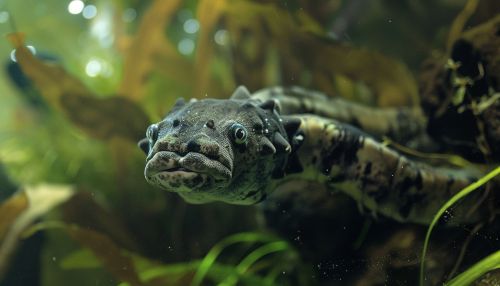Hydra
Overview
The Hydra is a genus of small, simple aquatic animals that belong to the phylum Cnidaria, which also includes jellyfish, sea anemones, and corals. Despite their simplicity, hydras are complex organisms with unique biological characteristics that have made them a subject of interest in various fields of biological research, including developmental biology, aging, and regeneration.


Anatomy and Morphology
Hydras are characterized by a tubular body structure that is typically 10 millimeters in length but can extend up to several centimeters when hunting or avoiding predators. The body is radially symmetrical and is divided into two main regions: the head, which contains the mouth and tentacles, and the foot, which is used for attachment to substrates.
The body wall of a hydra is composed of two main layers of cells: the outer epidermis and the inner gastrodermis, separated by a thin, non-cellular layer called the mesoglea. The epidermis contains specialized cells called cnidocytes, which are used for capturing prey and defense. The gastrodermis is responsible for digestion and nutrient absorption.
Reproduction
Hydras reproduce both sexually and asexually, a characteristic that is relatively rare among animals. In asexual reproduction, a process known as budding, a small outgrowth develops on the body of the parent hydra, grows into a new individual, and eventually detaches. Sexual reproduction involves the production of eggs and sperm, which combine to form a zygote that develops into a new individual.
Regeneration
One of the most fascinating aspects of hydras is their remarkable regenerative abilities. If a hydra is cut into pieces, each piece can regenerate into a complete organism. This ability is due to the presence of a high proportion of stem cells, which can differentiate into any cell type. The study of hydra regeneration has provided valuable insights into the mechanisms of cellular differentiation and tissue regeneration.
Ecology
Hydras are found in freshwater habitats around the world, including ponds, lakes, and slow-moving streams. They are predatory animals that feed on small aquatic invertebrates. Despite their small size, hydras play an important role in aquatic ecosystems by controlling the populations of their prey species.
Research and Scientific Significance
Due to their unique biological characteristics, hydras have been used as model organisms in various areas of biological research. Studies on hydras have contributed to our understanding of fundamental biological processes such as cell division, differentiation, and regeneration. In addition, hydras are one of the few organisms known to exhibit negligible senescence, or lack of aging, making them a subject of interest in aging research.
